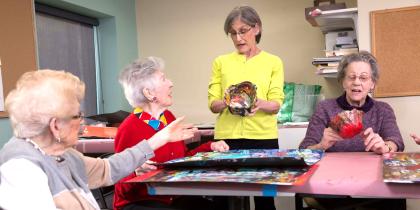Crafting Joy: The Benefits of Arts and Crafts for Seniors
Learn the health benefits of art-making and get inspired by these craft ideas.

Arts and crafts can be therapeutic to people of all ages, promoting well-being and relaxation while providing opportunities to connect with yourself and others. Creating art also offers seniors multiple health benefits, making it particularly worth considering as a new hobby.
If you want to unlock the benefits of art-making, our list of craft ideas for seniors is for you.
How does art-making benefit seniors?
There are multiple reasons for seniors to give arts and crafts a try.
“Art-making promotes connection between people and even with parts of yourself. It enhances positive emotion, it’s relaxing, it decreases agitation, and it promotes emotional regulation. It creates feelings of pride and satisfaction when you create something you’re happy with,” explains Hebrew SeniorLife Art Therapist Rachel Becker.
While art therapy has the added benefit of being facilitated by a licensed mental health professional, crafting at home still comes with perks. “Art-making, even by yourself, promotes self-expression, creativity, relaxation, and pride,” she adds.
Here are some of the top health benefits of taking up an artistic hobby:
It’s a mood-booster
Making art makes you feel good. That mood-boosting effect is true across different types of art forms.
One study found that handling clay is effective at decreasing negative moods. Another found that people who spent 30 minutes per day or more on arts activities during the pandemic had greater life satisfaction and lower rates of depression and anxiety than those who didn’t.
It fosters connection
Art and crafts done in a group setting promote connection. Social connection was a consistent benefit identified in a study that aimed to uncover how seniors engaged with textile arts and crafts during the pandemic.
A separate literature review of 12 studies found that art therapies targeting older adults living independently can promote socialization, mental well-being, and cognitive function, all of which are components of healthy aging.
It promotes cognitive function
Art is good for your brain health, too! Adults who participate in arts and crafts in midlife and late life have a decreased risk of developing mild cognitive impairment than those who don’t. Meanwhile, art therapy has been linked to improved cognitive function in community-living older adults with mild cognitive impairment.
It can ease chronic pain
Many older adults live with chronic pain due to health conditions. Recent studies have indicated that art-making may help relieve that pain. One study found that creating art can reduce pain severity and improve mood in older adults with chronic pain.
A 2018 study that looked at nearly 200 people hospitalized for a medical issue or surgery found that participating in art therapy for 50 minutes lowered pain and anxiety levels and significantly improved their moods.
Craft ideas for seniors
Our list of craft ideas for seniors can help you get started on your art-making journey:
Pick up painting
Painting is an intuitive art form that seniors can enjoy. If you have visual impairments, using bold, high-contrast colors can be helpful. Paint a still life or use a photo for inspiration. Watercolor paper holds up better than printer paper.
That’s not all you can do with paint. Another idea is to “fold a piece of paper in half, drop India ink, liquid watercolors, or tempera paint onto half the page, fold it in half, and rub it. Open the paper and talk about the image, then elaborate on the painting if desired,” explains Rachel.
Create a collage
Collages are an easy and non-intimidating art form. You can create collages out of images — for seniors with cognitive impairment, caregivers may want to consider cutting the images out ahead of time. Tissue paper collages are another fun option.
Mimic the work of famous artists
Look at photographs of a famous artist’s work and try to create something in their style. One example of an artist to use for this idea is Matisse, who created collages in his later years when he could no longer paint due to his health. Create your Matisse-inspired collage with cut-out pieces of paper, or find another famous artist who inspires you.
Knit, sew, or crochet
Textile arts like knitting, sewing, and crocheting help you keep busy, stay social, and maintain hand-eye coordination as you age. One study found that crocheting is good for personal well-being, helping people feel calmer, happier, and more productive. The same study found that many people were turning to crocheting to manage mental health conditions and difficult life events such as chronic illness, pain, and grief.
Use real flowers to create a nature-inspired still-life
You can also create a still life using real flowers. Flowers are a natural and immediate mood-booster and a great way to engage the senses. If making an entire bouquet on paper seems overwhelming, choose a single flower to paint or draw instead.
Play with clay
There’s a lot you can do with clay. Create a pinch pot or coil bowl and then paint it. Alternatively, go abstract, squeezing the clay and making something out of the shape that comes out of that. Another idea is to make a circle or square tile with the clay and press beads, shells, or beads into it to create ornaments.
Decorate wooden structures
Whether it’s a wooden frame, a birdhouse, or a box, objects that provide structure can be wonderful craft ideas that offer many possibilities. Paint or decorate them with buttons, beads, sea glass, or shells. If you’re decorating a birdhouse, you may want to consider making a small clay bird alongside it.
Enjoy kid-friendly crafts with your grandchildren
Art is an amazing way to connect with your family and friends, including the littlest ones in your life. If you have young grandchildren, simply drawing with them is a great way to bond. Or lean into simple craft ideas like painting rocks, finger painting, and making art with popsicle sticks. If they’re older, consider more complex art projects like tie-dying t-shirts or teaching them a skill you know like knitting or crocheting. Crayola offers many kid-friendly craft ideas if you’re looking for more options.
Consider trying multiple art forms
Remember that not every type of artwork is a good fit for everyone — and that’s okay! It could still be worth exploring another art form to see if it resonates with you.
“There is no one activity, subject matter, or material that will work with everyone. There is a lot of trial and error to figure out what each person enjoys. Don’t give up right away. Some people need repeated exposure and support to feel comfortable with art-making,” says Rachel.
Crafting with dementia or cognitive impairment
If you’re the caregiver of someone with dementia, you may wonder if crafting is possible for your loved one. In most cases, the answer is yes! However, you’ll likely need to provide extra guidance and support if their cognitive decline is moderate or severe.
You may need to ask them questions like “Do you want to choose a larger or smaller paintbrush?” or “What color do you like?” If they aren’t sure what to do next, you can gently take their hand and paint a few strokes so they can continue on their own or draw a light pencil outline for them to follow. If necessary, you can prompt them further by asking questions like “Do you like the blue or red paint?”
Try to allow the artwork to be as much of their own as possible. “It’s an opportunity for them to make choices, and they often don’t have a lot of choices in life. Give them as much freedom to choose as you can, but support them if they can’t,” advises Rachel.
Art is at the heart of Hebrew SeniorLife
Residents of Orchard Cove in Canton, MA, often discover new talents and hone existing skills through our extensive arts programming. One popular resident group crochets and knits blankets, teddy bears, and other items for children in need. Residents at NewBridge on the Charles in Dedham, MA, can explore their creativity in various classes in an expansive art studio or explore over 1,000 pieces of original artwork on display.
At Hebrew Rehabilitation Center in Roslindale and Dedham, long-term chronic care patients have access to expressive therapies to support their psychological, social, and emotional needs. Various expressive therapy modalities such as art therapy, music therapy, and bibliotherapy are used to encourage verbal and nonverbal means of communication and self-expression.
If you’re interested in learning more about our arts-focused care, we’re here to help. Connect with us online to learn more.
Blog Topics
Learn More
Expressive Therapies
Hebrew Rehabilitation Center provides its patients with many different kinds of expressive therapies to support their psychological, social, and emotional needs.



